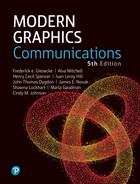FIFTH EDITION
Modern Graphics Communication

Engineers, technicians, and designers need to master a variety of graphical communication techniques, from sketching concepts, like these backpack designs, to creating detailed three-dimensional models suitable for analysis of design features. (Courtesy of André Cotan.)
About this Book
Modern Graphics Communication presents practices and techniques of sketching, visualization, design, and CAD that are important to today’s graphics curriculum. Based on the long-standing authoritative text on the subject, Giesecke’s Technical Drawing, this text preserves the time-tested graphics techniques that remain fundamental to the class, as it expands on the role that the 3D CAD database plays in design and documentation.
The topics of sketching and visualization skills are this book’s primary focus and provide a solid conceptual basis for the CAD instruction most graphics students receive. This edition also illustrates the application of both 3D and 2D modeling and technical drawing skills to real-world situations, and includes several in-depth case studies that link chapter content to industry practice. Each chapter lays a conceptual foundation that anchors the detailed sections on technique that follow. A wealth of step-by-step illustrated guides, tear-out worksheets, and end-of-chapter exercises help students visualize, practice, and retain those key concepts and techniques. Students who complete Modern Graphics Communication will leave with a full repertoire of skills—plus a lasting reference book—that they will find invaluable both in education and industry.
The Fifth Edition
The fifth edition of Modern Graphics Communication builds on Technical Drawing’s long history as an introduction to technical drawing and an easy-to-use reference for techniques and practices. This edition includes:
Hands-on worksheets, plus additional worksheets online.
Expanded coverage of 3D design and modeling techniques.
An updated introduction that illustrates the design documentation process with an industry case study.
Additional sketching content, including sketching assemblies and a case study on sketching for ideation.
New coverage of geometry useful for 3D modeling.
All new chapter on modeling tools and techniques.
More examples of plastic and sheet metal parts.
Updated coverage of modeling for manufacture with all new sections on using the model for simulation and analysis.
Updates to align with current ASME standards.
Two ongoing reverse engineering projects, introduced in Chapter 1.
Online chapters available for axonometric projection and perspective drawing.
Teaching/Learning Features
Visually-oriented students and busy professionals will quickly locate content by navigating these consistent chapter features.
Splash Spread An attention-getting chapter opener interests readers and provides context for chapter content.
References Applicable references to standards and links to handy websites are at the beginning of each chapter.
Foundations Section An introductory section, set off by a topic heading tab at the top of the page for easy navigation, covers the topic’s usage and importance, visualization tips, and theory related to the drawing techniques.
Detail Section This is the “brass tacks” part of the book, where detailed explanations of drawing and modeling techniques, variations, and examples are organized into quick-read sections, each numbered for quick reference in the detailed table of contents.
CAD at Work This breakout page includes tips related to using the 2D or 3D CAD model to generate drawings.
Industry Case 3D modeling practitioners share their best practices for modeling and documenting design.
Portfolio Examples of finished drawings wrap up the chapter by showing real-world application of topics presented.
Key Words Set in bold italics on first reference, key words are summarized at the end of the chapter.
Chapter Summary
Review Questions
Chapter Exercises The excellent Giesecke problem sets feature updated exercises, including plastic and sheet metal parts, modeling exercises, assembly drawings from CAD models, and sketching problems.
Worksheets Forty tear-out worksheets and grids at the end of the text provide additional practice with chapter topics. Additional worksheets are available online.
About the Author
Frederick E. Giesecke, founder of the first formal architectural education program in Texas at what is today Texas A&M University, has been described as “a wunderkind of the first magnitude.” He joined the A&M faculty at the age of 17, after graduating in 1886 with a B.S. in Mechanical Engineering. By the age of 19, was appointed head of A&M’s Department of Mechanical Drawing.
Having studied architectural drawing and design at Cornell University and the Massachusetts Institute of Technology, Giesecke also served as head of the Department of Architecture and the official college architect at Texas A&M, designing many campus buildings that are still standing today.
A long-time admirer of Giesecke’s legacy, Shawna Lockhart was honored to carry on the commitment to clear, engaging, thorough, and well-organized presentation that began with the original author.
Lockhart is known as an early adopter and authority on CAD technologies. She is an instructor noted for outstanding dedication to students and for encouraging a broad spectrum of individuals, particularly women and minorities, to follow careers in engineering-related fields. Lockhart first used Giesecke’s Technical Drawing when teaching engineering graphics at Montana State University and now works full time to ensure that the Giesecke graphics series continually applies to an evolving variety of technical disciplines.
Online Resources
Additional worksheets, appendices, exercises, and chapters on axonometric projection and perspective drawing may be downloaded from peachpit.com. To access the bonus content:
Visit peachpit.com/register.
Log in with your Peachpit account, or if you don’t have one, create an account.
Register using this book’s ISBN, 9780134848716, then click the Access Bonus Content link next to this book on your account’s Registered Products page.
To access the Instructor’s Manual and Lecture Slides in PowerPoint format, instructors need to go to www.pearsonhighered.com/irc to register for an instructor access code. Within 48 hours, you will receive your code via e-mail. Once you have your code, locate this text in the online catalog and click the Instructor Resources button on the left side of the page. Select a supplement, and a login page will appear. Once you have logged in, you can access instructor material for all Pearson textbooks. If you have any difficulty, get help at https://www.pearson.com/us/support.html.
